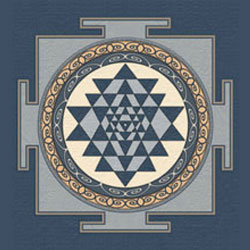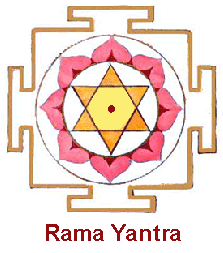The Meaning Behind Yantra

EDITOR’S NOTE:A Yantra course is given in February every year at Ananda Ashram in Pondicherry, India. An integral part of the paramparia of Swami Gitananda Giri, this profound body of knowledge is now taught through Swamiji’s son and successor Dr. Ananda Balayogi Bhavanani. The following article about the esoteric science of Yantra was written by Swami Gitananda nearly five decades ago … |
It has been said that India has produced three sciences: Yoga, Tantra and Yantra.
Yoga is the “practical path to oneness”, of having a complete or integrated life; of physical health, emotional balance, mental development, and spiritual awareness.
Tantra is the “mystical path to oneness” through the control of life’s hidden forces and powers; while yantra is the “geometric path to oneness” or unity by the understanding of spiritual geometry (sacred geometry).
India gave to the world the science of mathematics and theoretical geometry, and the genius of the Hindu mental intellect to find the meaning of the deeper mysteries of life is exemplified in yantra. In it, lines, shapes, figures, and designs are used to impart a hidden or concealed meaning. When one has the key to yantric meaning, mighty knowledge is released into the mind.
|
” The ALL in all is known through Samkhya (the Science of Numbers).” ~ Hindu Samkhya Axiom |
This esoteric science has sprung from sankhya, a main branch of Hinduism, which means “numbering” or the “science of numbers.” Yoga draws heavily upon sankhya for its scientific basis and reasoning. In yoga the use of yantras is an essential part of the study.
Laya yoga is the yoga of the arousal of latent human powers and energies and the re-absorbtion (transmutation) of these energies to a higher spiritual plane. Each of the processes or techniques is described by a mandala or geometric form (rupa) contained within a larger form or some complete yantra.
The chela or disciple is instructed by his guru or teacher in the hidden meanings so that only the yantric or geometrical form needs to be remembered. The process of remembering is taught in dharana and dhyana so that a near photographic memory is educed.
As an example: the yantra used for the Rama Navami Puja, or celebration of the anniversary of the birth of Lord Rama, contains in part the following brief meanings:

1. The circle in the centre symbolizes eternal life; life without beginning or end; completeness. If we placed a dot in the midst of the circle it would represent the monad, the cell, the atom or “man in life.”
2. The dot within the circle will also be noted by theosophists, metaphysicians, mystic Christians, Muslim Sufis and Jewish Essences as the symbol for the macrocosm (the total universe) and the microcosm (the individualized universe found in man, the cell, or the atom).
3. Also within the circle are two interlaced triangles referred to as the “Star of David” by our Jewish brethren. However, this powerful symbol predates Judaism by millennia. The triangle stands for the “Principle of Thirds.” The Hindu looks upon life as being trichotomous rather than dichotomous as in most Western thought. Life in its essence can be described in sets of “threes”.
SOME OF THESE TRINITIES MAY BE EXPRESSED AS:Brahma / Vishnu / Shiva Creator / Sustainer / Changer God the Father / the Son / the Holy Ghost Super Consciousness / Consciousness / Sub-Consciousness |
One triangle represents the Animal - Vegetable - Mineral kingdoms of the world, and the other the Physical - Mental - Spiritual nature of man. As well, a triangle with apex up represents the linga, or the male force and the triangle with apex down represents the yoni or female force. Hence, interlaced triangles represent union of male and female or the union of opposites.
4. The asthadala padma, or eight-petalled lotus, sunbursting out from the circle represents the shakti or “spiritual force” contained within the yantra - specifically in this case the physical nerve energy and the subtle shakti of the guru manas chakra, the “centre of the indwelling guru-teacher” of the higher mind.
5. The structure is bound by a square which stands for “spiritual principle” - the corner stone, the sacred rock. In India this is expressed by the four legitimate aims of life in Hinduism: artha (material pursuit); kama (pursuit of pleasure); dharma (fulfillment of obligation), and moksha (attaining spiritual freedom).
6. An equal-armed cross will be noted terminating at the top, bottom and both sides. This cross is the symbol of balance and peace. (In yantric symbology, an unequal-armed cross is the sign of pain and suffering, as in the Christian tradition). The Rama Yantra carries 46 numerals, and in mystical symbology represents the potential divine powers in the yantra. It is significant to note that Western science now declares there are 46 paired genes in the human cell (in the reproductive cell there are 23 genes in the male or positive, and 23 in the female or negative).
The “Spiritual Genes” or powers are controlled by the bija mantra “RUNG” (Ram), which in itself carries both the positive (Ra) and negative (Ma) united in perfect yoga or “union.” Lord Rama represents the Universal Law (Lord) of the Positive-Negative “Principle of Life” (Rama). “RA” in mathematics can be used to indicate addition and “MA” subtraction. Hence, the name “RA-MA” esoterically is a state of balance, equilibrium, preservation, conservation, when opposites remain united in a balanced state.
Rama is an incarnation of Vishnu, who is considered to be the “force which preserves.” Furthermore, it is said that when one utters the sound “RA” all evil tendencies and forces are pushed out from one’s mouth with the sound. When one utters the second syllable “MA”, the mouth closes firmly, and thus prevents these evil tendencies from entering again. Thus, as is the case with so many Hindu Deities, the name of the God is actually a powerful mantric sound with great esoteric significance. In their wisdom, the Rishis of this ancient spiritual culture thus set up a structure through which even the common man had access to profound spiritual realities.
The Rama Mantra was considered by Mahatma Gandhi to be the raft to carry man across the ocean of samskara and he engaged himself in constant Ram Japa, or repetition of the name of Rama. As he fell to his assassin’s bullet - only one sound escaped the great Mahatma’s lips - the sound RAM!
Thus one can see the wealth of spiritual instruction contained within a simple shape such as the Ram Mandala. All these concepts are part and parcel of the great science of yantra, a science that provides another useful tool with which to carve an ordered, purposeful life from the otherwise apparent chaos of human existence.
More on the the esoteric science of Yantra …
About the Author:
Yogamaharishi Dr Swami Gitananda Giri Guru Maharaj (1907-1993) was one of the most potent and effective forces in the field of ashtanga yoga worldwide.
Learn more about Swami Gitananda here …
Also visit the International Centre for Yoga Education and Research

